Environmental Technology Market Research, 2032
The global environmental technology market was valued at $0.7 trillion in 2022, and is projected to reach $1.2 trillion by 2032, growing at a CAGR of 5.1% from 2023 to 2032.
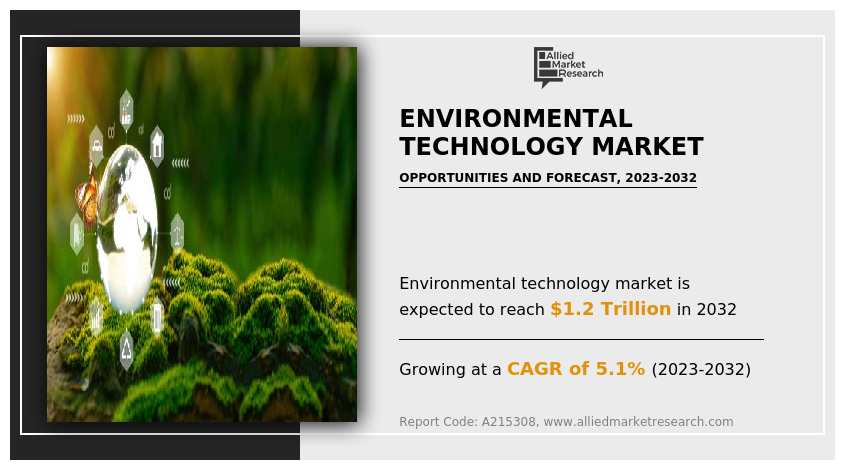
Introduction
Environmental technology, also known as green technology, refers to a broad range of innovative solutions, processes, and products that are designed to address environmental challenges and promote sustainability. The primary goal of environmental technology industry is to diminish the adverse effects of human activities on the environment, conserve natural resources, and minimize pollution and waste generation.
Report Key Highlighters:
- The report provides competitive dynamics by evaluating business segments, product portfolios, target market revenue, geographical presence and key strategic developments by prominent manufacturers.
- The environmental technology market is fragmented in nature among prominent companies such as AECOM, Clean Harbors Inc., Covanta Holding Corporation, Ecolab Inc., Engie Impact, IDEX Corporation, Suez, Veolia, Waste Management, and Xylem.
- The study contains qualitative information such as the market dynamics (drivers, restraints, challenges, and opportunities), key regulation analysis, pricing analysis, and Porter’s Five Force Analysis across North America, Europe, Asia-Pacific, and LAMEA regions.
- Latest trends in global environmental technology market such as undergoing R&D activities, public policies, and government initiatives are analyzed across 16 countries in 4 different regions.
- More than 2,500 environmental technology-related product literatures, industry releases, annual reports, and other such documents of key industry participants along with authentic industry journals and government websites have been reviewed for generating high-value industry insights for global environmental technology market.
Market Dynamics
Rise in awareness of environmental issues such as climate change, pollution, resource depletion, and habitat destruction has led to increased demand for technologies that can mitigate these problems. Government regulations and international agreements also drive the adoption of environmental technologies to meet emissions reduction targets and environmental standards. Increase in public awareness of environmental issues has led to consumer preferences for eco-friendly products and services. This demand drives businesses to adopt sustainable practices and technologies. As part of companies CSR programs, many businesses understand how crucial it is to integrate their operations with environmental sustainability. This involves implementing technology that lessens their environmental impact and carbon footprint.
Furthermore, increase in demand for environmental technologies in the emerging regions due to the rising population, rapid urbanization, and industrialization are the key factors driving the environmental technology market forecast. In addition, rise in demand for renewable energy resources such as wind, solar, geothermal energy, and stringent regulations regarding environment protection are further propels environmental technology market growth.
In January 2021, the U.S. officially rejoined the Paris Agreement, an international treaty aimed at combating climate change by reducing greenhouse gas emissions. This denoted a reaffirmed dedication to international climate action. By 2035, the Biden administration aims to generate all of the nation's electricity from renewable energy sources such as wind and solar and reduce reliance on fossil fuels. Moreover, Biden administration's American Jobs Plan featured large investments in infrastructure, including improvements to the energy, water, and transportation networks to increase effectiveness and minimize environmental impacts. The U.S. administration issued several executive orders aimed to address issues such as climate change, preventive measures to enhance vehicle fuel efficiency standards, establish climate considerations in federal procurement, and set ambitious emissions reduction targets.
In 2022, World Bank, Solar Energy Corporation of India Limited (SECI), and the Government of India signed agreements for a $150 million International Bank for Reconstruction and Development (IBRD) loan, a $28 million loan from the Clean Technology Fund (CTF), and a $22 million grant from the CTF that will aid India to boost the amount of clean, renewable energy it can produce. In order to address the challenges of climate change, the agreement highlights the Government of India's goal to generate 500 GW of renewable energy by 2030. India currently has an installed capacity of more than 409 GW, of which the renewable energy (non-hydro) share is almost 29 % (119.5 GW). The project will accelerate India’s progress towards sustainable universal electricity access, which is a key milestone for achieving inclusive economic development objectives.
According to the IEA World Energy Investment 2023 report, spending on fossil fuels is significantly outpaced by investment in renewable energy technologies due to concern about affordability and security brought on by the global energy crisis. Between 2021 and 2023, annual investments in clean energy are anticipated to increase by 24%, led by renewables and electric cars, as compared to a 15% increase in investments in fossil fuels throughout the timeframe. C-Zero Inc., a clean energy company developed a technology for natural gas decarbonization in 2022. Public funds for energy research, development, and demonstration (R&D) in IEA member countries fell by 2% to an expected $22.3 billion in 2022. Notably, due to China increasing its contribution of low-carbon energy R&D over the previous five years, public expenditure on low-carbon energy R&D scaled at an almost 7% annual growth rate, surpassed total energy R&D budgets.
The Asia-Pacific region encompasses a diverse range of countries with varying levels of industrialization and economic development. This diversity has led to a complex set of environmental challenges, including air and water pollution, waste management issues, and growing energy consumption. As a result, there is a strong demand for innovative solutions that can address these challenges effectively. The Asia Pacific region is indeed the largest crude oil importing region globally. Many countries in the region have rapidly growing economies and industries that rely heavily on imported fossil fuels, including crude oil, to meet their energy needs. This heavy reliance on fossil fuels contributes to both air pollution and greenhouse gas emissions, prompting a need for cleaner and more sustainable energy sources.
Rapid development and energy consumption in Asia-Pacific have resulted in environmental challenges such as air pollution, water pollution, deforestation, and habitat loss. These issues have prompted governments and industries to seek ways to mitigate negative impacts and transition toward more sustainable practices. The growth of the environmental technology market size is also fueled by investments in research and development. In conclusion, the Asia Pacific is the largest environmental technology market share for and is influenced by its substantial crude oil imports, rapid population growth, and significant energy demand. These factors drive the need for sustainable solutions in areas such as renewable energy, energy efficiency, and pollution reduction.
The solutions segment held a dominant position in the global environmental technology market due to growing concern associated with the increased carbon footprint and environmental impacts caused by human activities. This segment encompasses a wide range of innovative solutions aiming to address various environmental challenges, from climate change to pollution. The growing recognition of the urgent need to mitigate these challenges drove the demand for solutions that can effectively reduce negative environmental impacts. This includes technologies and strategies designed to minimize resource consumption, optimize energy efficiency, promote sustainable practices, and reduce greenhouse gas emissions. As individuals, businesses, and government became more conscious of their carbon footprint and environmental responsibility, the demand for these environmental solutions surged, contributing to the segment's dominance in the market.
Waste Valorization offers a solution to extract maximum value from materials that might be discarded. It complies with the principles of sustainability by minimizing resource depletion and promoting a circular economy. It helps significantly reduce the environmental burden of waste disposal. By diverting waste from landfills and incineration, it mitigates pollution, decreases greenhouse gas emissions, and conserves valuable land and energy resources. It also helps recover valuable resources from garbage, lowers disposal costs while also generating income from recyclable, reusable, or energy-producing materials. This economic incentive encourages businesses and industries to adopt waste valorization practices. Rapid advancements in technology have expanded the possibilities of waste valorization. The effectiveness and efficiency of waste valorization have increased due to innovations such as advanced recycling techniques, chemical conversion procedures, and biological treatments.
Environmental regulations and policies are increasingly pushing industries and communities to adopt sustainable waste management practices. Growing environmental awareness among consumers and investors has led to increased demand for sustainable and eco-friendly practices. In conclusion, the dominance of waste valorization in the environmental technology segment is a result of its ability to address critical problems such as resource scarcity and environmental degradation.
Wastewater treatment plays a crucial role in environmental technology due to its significance in addressing the environmental and public health challenges related to industrialization and urbanization. Wastewater produced by businesses and communities in industrialized areas often contains a variety of pollutants and toxins. Direct discharge of untreated wastewater into water bodies has the potential to contaminate water sources, which could have an adverse effect on downstream aquatic ecosystems, wildlife, and human populations. Governments and environmental agencies implement strict regulations to control the quality of discharged wastewater. These regulations aim to limit the levels of pollutants and ensure that the effluent does not harm the environment or human health.
Market Segmentation
The environmental technology market scope is segmented into component, application, consumer/vertical and region. On the basis of component, it is bifurcated into solutions and services. On the basis of application, the market is classified into water purification management, wastewater treatment, solid waste management, environmental monitoring and others. On the basis of consumer/vertical, the market is divided into residential, industrial and municipal. Region wise, the market is studied across North America, Europe, Asia-Pacific, and LAMEA.
By Component
Based on component, the services segment held the highest market share in 2022, accounting for nearly three-fourths of the global environmental technology market revenue, and is estimated to maintain its leadership status throughout the forecast period. Environmental services refer to the expertise, guidance, and support offered by professionals and organizations to help others address environmental challenges, comply with regulations, and improve sustainability practices.
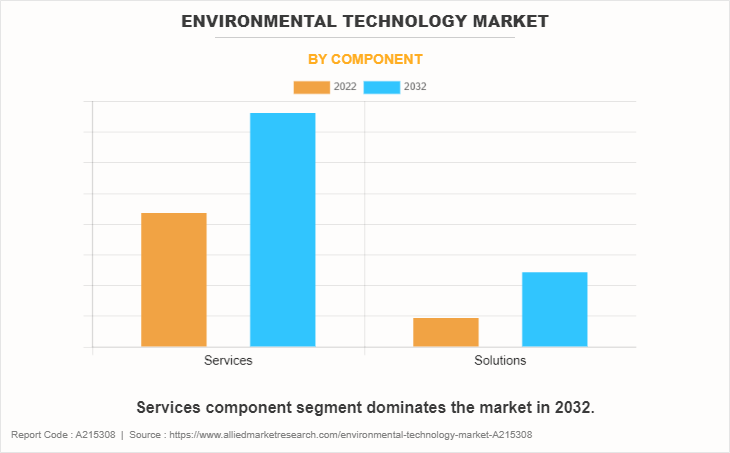
By Application
Based on application, solid waste management segment held the highest market share in 2022, accounting for more than one-third of the global environmental technology market revenue, and is estimated to maintain its leadership status throughout the forecast period. It can be adjusted over time to respond to changes in emission reduction targets, technological advancements, and economic conditions.
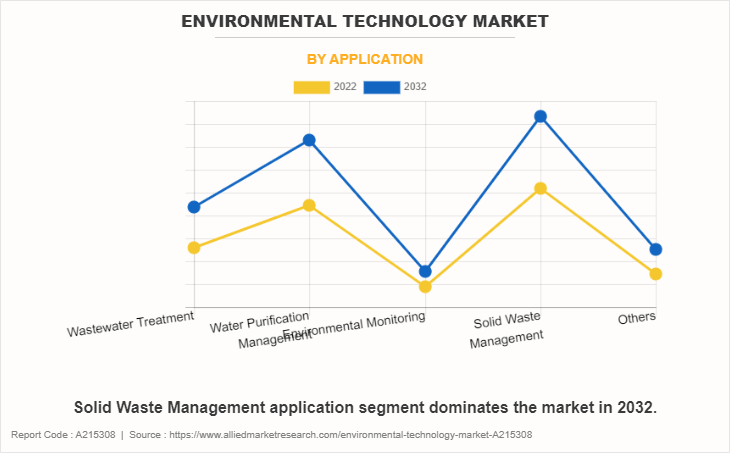
By Consumer
Based on the consumer, the industrial held the highest market share in 2022, accounting for more than two-fifths of the global environmental technology market revenue, and are estimated to maintain their leadership status throughout the forecast period. Industrial processes often generate significant waste. Environmental technologies enable efficient waste management, recycling, and waste-to-energy conversion, reducing landfill use and promoting a circular economy.
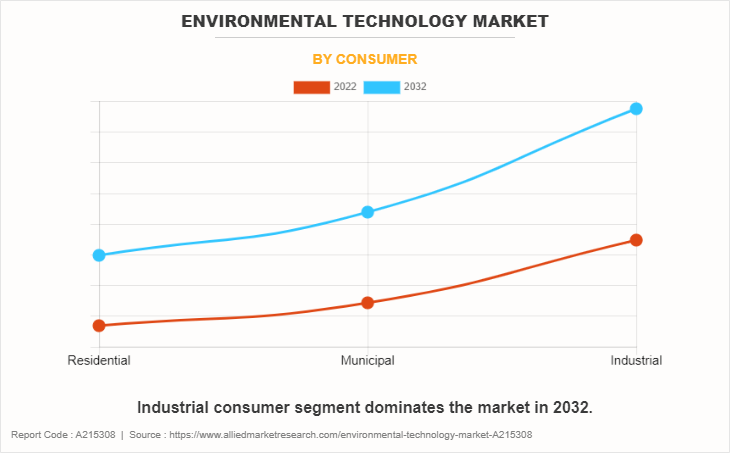
By Region
Based on region, Europe held the highest market share in terms of revenue in 2022, accounting for more than one-third of the global environmental technology market revenue, and is likely to dominate the market during the forecast period. Furthermore, the Asia-Pacific region is expected to witness the fastest CAGR of 6.3% from 2023 to 2032. The Asia-Pacific region presents significant growth potential in environmental technology. Emerging markets, such as India, China, and Southeast Asian countries, have witnessed rapid industrial growth which will lead to increased demand for environmental technology.
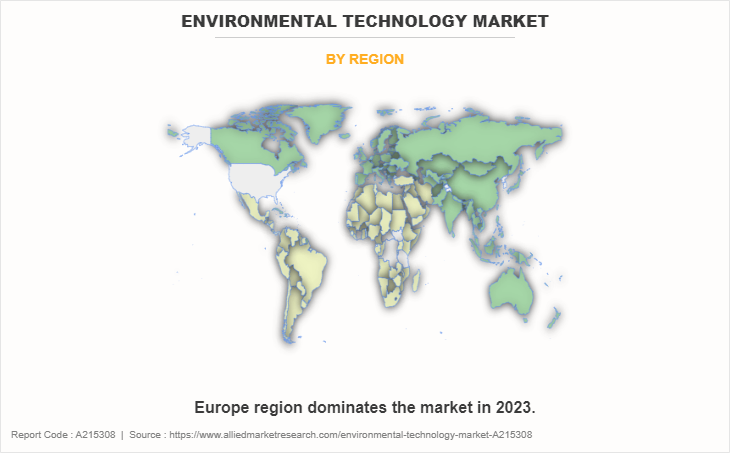
Competitive Landscape
The major companies profiled in this report include AECOM, Clean Harbors Inc., Covanta Holding Corporation, Ecolab Inc., Engie Impact, IDEX Corporation, Suez, Veolia, Waste Management and Xylem.
Key Benefits for Stakeholders
- This report provides a quantitative analysis of the market segments, current trends, estimations, and dynamics of the environmental technology market analysis from 2022 to 2032 to identify the prevailing environmental technology market opportunities.
- The market research is offered along with information related to key drivers, restraints, and opportunities.
- Porter's five forces analysis highlights the potency of buyers and suppliers to enable stakeholders make profit-oriented business decisions and strengthen their supplier-buyer network.
- In-depth analysis of the environmental technology market segmentation assists to determine the prevailing market opportunities.
- Major countries in each region are mapped according to their revenue contribution to the global market.
- Market player positioning facilitates benchmarking and provides a clear understanding of the present position of the market players.
- The report includes the analysis of the regional as well as global environmental technology market trends, key players, market segments, application areas, and market growth strategies.
Environmental Technology Market Report Highlights
| Aspects | Details |
| Market Size By 2032 | USD 1.2 trillion |
| Growth Rate | CAGR of 5.1% |
| Forecast period | 2022 - 2032 |
| Report Pages | 360 |
| By Component |
|
| By Application |
|
| By Consumer |
|
| By Region |
|
| Key Market Players | Veolia, Clean Harbors Inc., IDEX Corporation, Ecolab Inc., Xylem, Engie Impact, Suez, AECOM, Covanta Holding Corporation, Waste Management |
Analyst Review
According to CXO perspective, the global environmental technology market is expected to witness increased demand during the forecast period due to a rise in demand from industrial sectors.
Rise in government initiatives towards sustainability and green technology which include recycling waste, wastewater treatment, carbon offset monitoring, and conserve natural resources are expected to propel the growth of the environmental technology market. The UK will provide an "India Green Guarantee" to the World Bank, to unlock an additional $820 million or green projects across India, it was announced at the COP26 summit in 2021. Further, in an aid-backed Private Infrastructure Development Group (PIDG), the UK has committed more than 210 million pounds in new investment at the UN climate summit to back transformational green projects in developing countries, including electric vehicles (EVs) in India.
Vehicles are the largest single contributor of greenhouse gases. Around 27% of all greenhouse gas emissions in the U.S. come from transportation, according to 2020 research from the EPA. For instance, companies developed electric vehicles more mainstream. Illinois-based company Hyzon Motors specifically designs battery technology for commercial sector vehicles like trucks and buses. San Francisco-based companies Chargepoint and Volta Charging build out the infrastructure to support electric vehicle adoption by developing and installing EV charging stations.
Renewable Energy and Energy Efficiency Circular Economy Solutions, Smart Cities and Infrastructure, Water and Air Quality Management, Waste Management Innovations are the upcoming trends of Environmental Technology Market in the world
Solid waste management is the leading application of Environmental Technology Market.
Europe is the largest regional market for Environmental Technology.
$1.2 trillion is the estimated industry size of Environmental Technology.
IDEX Corporation, Suez, Veolia, Waste Management and Xylem. are the top companies to hold the market share in Environmental Technology
Loading Table Of Content...
Loading Research Methodology...



